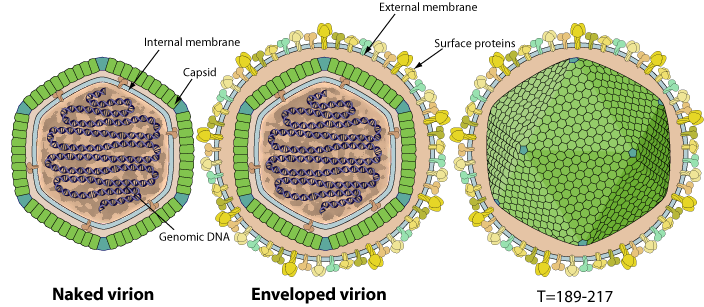Betairidovirinae (taxid:2017757)
VIRION

Polyhedral virions 185 nm in diameter. The capsid displays an icosahedral symmetry T=147, with an internal lipid membrane. Virions are either externally enveloped or not depending whether they budded from the cell membrane, or were arranged in paracrystaline array in the host cell cytoplasm and were released by lysis.
- Hexons: Double jelly roll-fold major capsid protein [Q05815]
- Pentons: Single jelly roll-fold [?]
GENOME
Linear, dsDNA genome of 135 to 213 kb. The genome contains terminal and redundant sequences and is circularly permuted. According to a recent estimation, IIV-6 genome might encode about 211 proteins. The genome is not methylated.
GENE EXPRESSION
there are classical or slightly modified canonical promoters and termination signals upstream and downstream of the start and stop codons of most ORFs.
ENZYMES
- DNA-directed DNA polymerase
- DNA-directed RNA polymerase
- Cell-type capping
- Cysteine protease (Peptidase C1A)
REPLICATION
NUCLEO-CYTOPLASMIC
- Attachment of the viral proteins to host receptors mediates endocytosis of the virus into the host cell.
- Fusion with the plasma membrane to release the DNA core into the host cytoplasm.
- Viral DNA is transported to the cell nucleus where host macromolecular synthesis is rapidly shutdown. Transcription is initiated by virally modified host RNA polymerase II.
- Parental DNA is used to produce genome and greater than genome length DNA.
- Progeny DNA is transported into cytoplasmic viral factories where large concatamers of viral DNA are formed by recombination. Transcription of very late transcripts may also take place in the cytoplasm.
- Assembly of new virions in the cytoplasm.
- Virions exit the cell by budding or cell lysis.
Host-virus interaction
Apoptosis modulation
Chilo iridescent virus encodes a functional inhibitor of apoptosis (IAP)  . The grouper iridovirus (GIV) contains an antiapoptotic B-cell lymphoma (Bcl)-2-like gene
. The grouper iridovirus (GIV) contains an antiapoptotic B-cell lymphoma (Bcl)-2-like gene  that also inhibits host apoptosis.?
that also inhibits host apoptosis.?
Invertebrate iridescent virus 3 encodes a protein homolog to the Chilo iridescent virus functional inhibitor of apoptosis (IAP)  . This ORF may therefore play a role in the modulation of host apoptosis.
. This ORF may therefore play a role in the modulation of host apoptosis.
Matching UniProtKB/Swiss-Prot entries
(all links/actions below point to uniprot.org website)347 entries grouped by strain
215 entries
Invertebrate iridescent virus 6 (IIV-6) (Chilo iridescent virus) reference strain
126 entries
Invertebrate iridescent virus 3 (IIV-3) (Mosquito iridescent virus) reference strain
2 entries
Simulium iridescent virus (IIV-22) (Insect iridescent virus type 22)
2 entries
Tipula iridescent virus (TIV) (Insect iridescent virus type 1)
1 entry
Costelytra zealandica iridescent virus (CzIV) (Insect iridescent virus type 16)
1 entry
